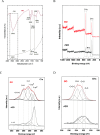Advancing Albumin Isolation from Human Serum with Graphene Oxide and Derivatives: A Novel Approach for Clinical Applications
- PMID: 39371982
- PMCID: PMC11447712
- DOI: 10.1021/acsomega.4c04276
Advancing Albumin Isolation from Human Serum with Graphene Oxide and Derivatives: A Novel Approach for Clinical Applications
Abstract
This study introduces a novel, environmentally friendly albumin isolation method using graphene oxide (GO). GO selectively extracts albumin from serum samples, leveraging the unique interactions between GO's oxygen-containing functional groups and serum proteins. This method achieves high purification efficiency without the need for hazardous chemicals. Comprehensive characterization of GO and reduced graphene oxide (rGO) through techniques such as X-ray diffraction (XRD) analysis, Raman spectroscopy, scanning electron microscopy (SEM), and Fourier transform infrared spectroscopy (FTIR) confirmed the structural and functional group transformations crucial for protein binding. Sodium dodecyl sulfate-polyacrylamide gel electrophoresis (SDS-PAGE) and mass spectrometry analyses demonstrated over 95% purity of isolated albumin, with minimal contamination from other serum proteins. The developed method, optimized for pH and incubation conditions, showcases a green, cost-effective, and simple alternative for albumin purification, promising broad applicability in biomedical research and clinical applications.
© 2024 The Authors. Published by American Chemical Society.
Conflict of interest statement
The authors declare no competing financial interest.
Figures











Similar articles
-
An in vitro evaluation of graphene oxide reduced by Ganoderma spp. in human breast cancer cells (MDA-MB-231).Int J Nanomedicine. 2014 Apr 8;9:1783-97. doi: 10.2147/IJN.S57735. eCollection 2014. Int J Nanomedicine. 2014. PMID: 24741313 Free PMC article.
-
Ginkgo biloba: a natural reducing agent for the synthesis of cytocompatible graphene.Int J Nanomedicine. 2014;9:363-77. doi: 10.2147/IJN.S53538. Epub 2014 Jan 7. Int J Nanomedicine. 2014. PMID: 24453487 Free PMC article.
-
A Novel Biomolecule-Mediated Reduction of Graphene Oxide: A Multifunctional Anti-Cancer Agent.Molecules. 2016 Mar 18;21(3):375. doi: 10.3390/molecules21030375. Molecules. 2016. PMID: 26999102 Free PMC article.
-
An environmentally friendly approach to the reduction of graphene oxide by Escherichia fergusoni.J Nanosci Nanotechnol. 2013 Mar;13(3):2091-8. doi: 10.1166/jnn.2013.6738. J Nanosci Nanotechnol. 2013. PMID: 23755651
-
Recent advances in the use of graphene-family nanoadsorbents for removal of toxic pollutants from wastewater.Adv Colloid Interface Sci. 2014 Feb;204:35-56. doi: 10.1016/j.cis.2013.12.005. Epub 2013 Dec 26. Adv Colloid Interface Sci. 2014. PMID: 24412086
References
-
- de Richter E. A.; Kiens B.; Galbo H.; Saltin B.. Skeletal Muscle Metabolism in Exercise and Diabetes (Advances in Experimental Medicine and Biology), 1st ed.; Springer, 1998; p 441.
LinkOut - more resources
Full Text Sources
